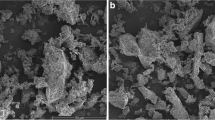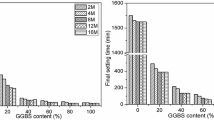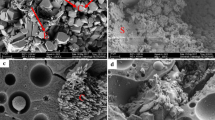Abstract
Geopolymer specimens were prepared by combination of fly ash and metakaolin activated by sodium silicate (\({{\rm Na}_{2}{\rm SiO}_{3}}\)) and sodium hydroxide (NaOH) solutions. The effect of high temperature on the compressive strength, mass loss and shrinkage of geopolymer cement pastes and ordinary portland cement (OPC) pastes were assessed experimentally. Microstructure formation and development were characterized in terms of pore structure by mercury intrusion porosimetry. The results reveal that at temperatures exceeding \({400\,^{\circ}{\rm C}}\) geopolymer cement paste is superior to OPC paste. Firstly, the compressive strength drops rapidly for the OPC paste to practically zero strength at \({600\,^{\circ}{\rm C}}\) , while it drops slowly for the fly ash–metakaolin-based geopolymer cement paste to 46 MPa at \({1000\,^{\circ}{\rm C}}\) . Secondly, while the mass loss increases for the OPC paste, it is maintained at a constant, lower value for the geopolymer cement paste. Thirdly, shrinkage of geopolymer cement paste is at least three times smaller than that of OPC paste.
Similar content being viewed by others
References
Temuujin J., Rickard W., Lee M., van Riessen A.: Preparation and thermal properties of fire resistance metakaolin-based geopolymer-type coatings. J. Non Cryst. Solids 357(5), 1399–1404 (2011)
Zhang J.Y., Li S., Wang Y.C., Xu D.L.: Microstructural and strength evolutions of geopolymer composites reinforced by resin exposed to elevated temperature. J. Non Cryst. Solids 358(3), 620–624 (2012)
Rickard W.D.A., Temuujin J., van Riessen A.: Thermal analysis of geopolymer pastes synthesized from five fly ashes of variable composition. J. Non Cryst. Solids 358(15), 1830–1839 (2012)
Autef A., Joussein E., Gasgnier G., Rossignol S.: Role of the silica source on the geopolymerization rate: A thermal analysis study. J. Non Cryst. Solids 366(15), 13–21 (2013)
Aredes F.G.M., Campos T.M.B., Machado J.P.B., Sakane K.K., Thim G.P., Brunelli D.D.: Effect of cure temperature on the formation of metakaolinite-based geopolymer. Ceram. Int. 41(6), 7302–7311 (2015)
Sarker P.K., Mcbeath S.: Fire endurance of steel reinforced fly ash geopolymer concrete elements. Constr. Build. Mater. 90, 91–98 (2015)
Pangdaeng S., Phoo-ngernkham T., Sata V., Chindaprasirt P.: Influence of curing conditions on properties of high calcium fly ash geopolymer containing Portland cement as additive. Mater. Des. 53, 269–274 (2014)
Yuan X.H., Chen W., Lu Z.A., Chen H.G.: Shrinkage compensation of alkali-activated slag concrete and microstructural analysis. Constr. Build. Mater. 66(15), 422–428 (2014)
EN 1015-6, European Standard: Methods of test for mortar for masonry-Part 6: Determination of bulk density of fresh mortar. European Committee for Standardization (CEN) (1998)
Shoaib M.M., Ahmed S.A., Balaha M.M.: Effect of fire and cooling mode on the properties of slag mortars. Cem. Concr. Res. 31, 1533–1538 (2001)
Mendes A., Sanjayan J.G., Gates W.P., Collins F.: The influence of water absorption and porosity on the deterioration of cement paste and concrete exposed to elevated temperatures, as in a fire event. Cem. Concr. Compos. 34, 1067–1074 (2012)
Palomo A., Grutzeck M.W., Blanco M.T.: Alkali-activated fly ashes: a cement for the future. Cem. Concr. Res. 29(8), 1323–1329 (1999)
Rahier H., van Mele B., Wastielsm J.: Low-temperature synthesized aluminosilicate glasses part II rheological transformations during low-temperature cure and high temperature properties of a model compound. J. Mater. Sci. 31(1), 80–85 (1996)
Duxson P., Lukey G.C., van Deventer J.S.J.: Physical evolution of Na-geopolymer derived from metakaolin up to \({1000^{\circ}{\rm C}}\). J. Mater. Sci. 42(9), 3044–3054 (2007)
Douglas E., Bilodeau A., Malhotra V.M.: Properties and durability of alkali-activated slag concrete. ACI Mater. J. 89(5), 509–516 (1992)
Wang S.D., Pu X.C., Scrivener K.L., Pratt P.L.: Alkali-activated slag cement and concrete: a review of properties and problems. Adv. Cem. Res. 7(27), 93–102 (1995)
Collins F., Sanjayan J.G.: Microcracking and strength development of alkali activated slag concrete. Cem. Concr. Res. 23(4), 345–352 (2001)
Rostasy F.S., Weib R., Wiedemann G.: Changes of pore structure of cement mortars due to temperature. Cem. Concr. Res. 10, 157–164 (1980)
Shoaib M.M., Ahmed S.A., Balaha M.M.: Effect of fire and cooling mode on the properties of slag mortars. Cem. Concr. Res. 31, 1533–1538 (2001)
Yuzer N., Akoz F., Dokuzer Ozturk L.: Compressive strength–color change relation in mortars at high temperature. Cem. Concr. Res. 34, 1803–1807 (2004)
Georgali B., Tsakiridis P.E.: Microstructure of fire-damaged concrete. A case study. Cem. Concr. Compos. 27, 255–259 (2005)
Yüzer N., Aköz F., Dokuzer Öztürk L.: Compressive strength–color change relation in mortars at high temperature. Cem. Concr. Res. 34, 1803–1807 (2004)
Ranjbar N., Mehrali M., Alengaram U.J., Metselaar H.S.C., Jumaat M.Z.: Compressive strength and microstructural analysis of fly ash/palm oil fuel ash based geopolymer mortar under elevated temperatures. Constr. Build. Mater. 65, 114–121 (2014)
Abdulkareem O.A., Al Bakri A.M.M., Kamarudin H., Nizar I.K., Saif A.A.: Effects of elevated temperatures on the thermal behavior and mechanical performance of fly ash geopolymer paste, mortar and lightweight concrete. Constr. Build. Mater. 50, 377–387 (2014)
Diamond S.: Mercury porosimetry: an inappropriate method for the measurement of pore size distributions in cement-based materials. Cem. Concr. Res. 30(10), 1517–1525 (2000)
Akkaya Y., van Breugel K., Shah S.P.: Rheological model for self-consolidating concrete. ACI Mater. J. 99(6), 549–559 (2002)
Zhang S.P., Zong L.: Evaluation of relationship between water absorption and durability of concrete materials. Adv. Mater. Sci. Eng. 2014, 373–380 (2014)
Lai W.L., Tsang W.F.: Characterization of pore systems of air/water-cured concrete using ground penetration radar(GPR) through continuous water injection. Constr. Build. Mater. 22, 250–256 (2008)
Author information
Authors and Affiliations
Corresponding author
Rights and permissions
About this article
Cite this article
Duan, P., Yan, C., Zhou, W. et al. Thermal Behavior of Portland Cement and Fly Ash–Metakaolin-Based Geopolymer Cement Pastes. Arab J Sci Eng 40, 2261–2269 (2015). https://doi.org/10.1007/s13369-015-1748-0
Received:
Accepted:
Published:
Issue Date:
DOI: https://doi.org/10.1007/s13369-015-1748-0




